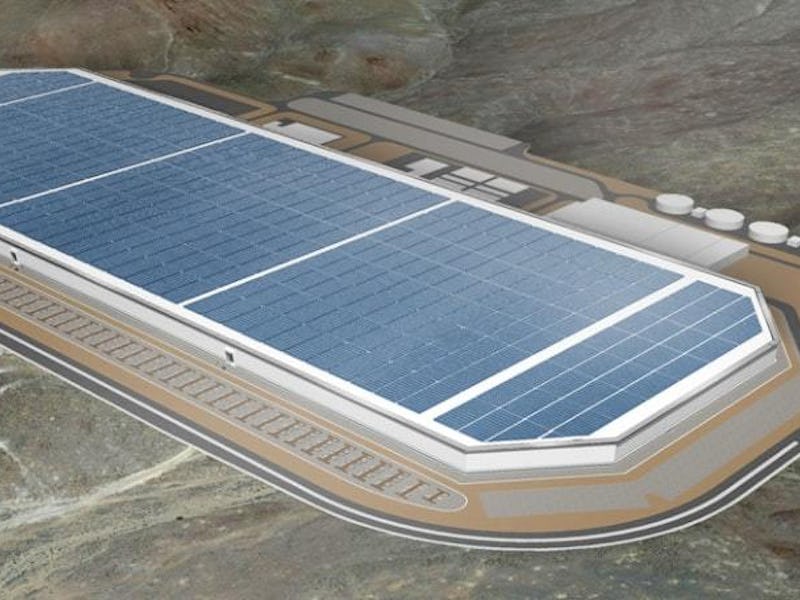Tesla may not yet be finished with construction of the first Gigafactory, but the company’s already thinking about the next four. In the company’s earnings report released Wednesday, Tesla announced that it is already planning Gigafactory 3, 4, and 5.
“Later this year, we expect to finalize locations for Gigafactories 3, 4, and possibly 5 (Gigafactory 2 is the Tesla solar plant in New York),” projects the letter to shareholders.
As for when we’ll find out more, though, Musk is remaining tight-lipped. Charlie Anderson, Wall Street analyst at Dougherty, asked Musk for more details about the new factories, but the Tesla CEO refused to give away any more information.
“I think we’ll reserve, keep some powder dry for those announcements later this year,” Musk told investors during a conference call after the release of the fourth quarter 2016 earnings report. “This probably wasn’t enough news for today, but I think those announcements are really quite exciting later this year.”
The locations of the three newly announced factories will be revealed in the coming year, but it’s all part of a plan to use robots and automation to make Tesla into a manufacturing giant.
“I think in the future, the factory will be a more important product than the car itself,” Musk said during the investor call. “I’ve said this before, but our goal is to be the best manufacturer on earth.”
The first Gigafactory has been a major cornerstone of Elon Musk’s push to transform global energy consumption, producing both batteries and cars. When fully complete, it’s expected to produce batteries faster than bullets from a machine gun. This is thanks to a combination of size, scale, and robot automation.
Self-driving machines like this Adept Lynx ferry parts around the factory to different workstations. This one is able to carry up to 90 kg (198 pounds) and even charge itself:
These lightweight machines complement the heavy duty bots used on the production floor. The one in this video can handle weights of up to 360 kg (794 pounds). Musk has described the Gigafactory as “the machine that builds the machine,” and it’s easy to see why:
“There’s a lot more automation [manufacturing the Model 3] than there is for S and X,” Musk said in the investor call. “We have the Gigafactory [making] powertrains, power electronics, charger, a few other things. That’s a huge asset.”
The Gigafactory’s production capacity is so great that 100 Gigafactories would be enough to completely transition the world onto renewable energy. The whole factory is expected to exceed five billion square feet when complete, making it the world’s largest building by footprint. This capacity comes at a price, though: construction costs exceeded $1 billion earlier this month.
The other three Gigafactories will have a lot to live up to, but a recent acquisition suggests they’ll be highly advanced. Last November, Tesla announced plans to buy Grohmann Engineering to automate the manufacturing process.
But an increase in efficiency won’t just come from robot automation. The company will be able to use its experiences from Model X production when it comes to increasing efficiency on producing future vehicles.
“A lot of these things that we could identify directly as the bottlenecks that hurt us on the X ramp, we’ve been able to target specifically and reduce or eliminate,” Jeff Evanson, vice president of investor relations, said during the investor call. “So that has, though painful, it was a very helpful experience for us to get ready for the Model 3.”
Interestingly, the earnings report also revealed that “Gigafactory 2” is the 1.2-million square foot solar panel factory in Buffalo, New York. The production plant, scheduled to go online this summer, was originally a SolarCity project, until the company merged with Tesla in November through a $2.6 billion deal.
The solar factory is a big deal for Tesla, as it ties into Musk’s clean energy vision where the company’s cars are recharged through renewable energy sources. In December, Panasonic committed to investing $255 billion in the company’s solar efforts, building on the existing solar partnership by providing technological expertise to get production off the ground. The two companies hope to increase photovoltaic module production at the New York factory to one gigawatt by 2019.
With Gigafactory 1 and 2 spoken for, the big question is where these other three Gigafactories are going to be placed. Tesla previously claimed that the next Gigafactory would be located in Europe, but where exactly is unclear. No matter where they’re placed, they’ll play a vital role in Tesla’s ultimate goal to produce 500,000 cars per year by the year 2018.
